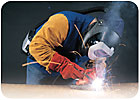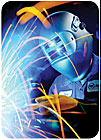
Welders regularly deal with a difficult work environment — heat; dirty, dusty air; and smoke from welding rods. The smoke from melted metal, also called welding fumes, contains tiny particles of metal thrown off during welding by the welding rods, the metals being welded, and any coatings present on those metals. Welders generally avoid these particulates in the fumes by working with adequate ventilation. Yet, health-conscience employers can ensure that welders work safely by providing special respiratory protection. Understanding the most effective ways to increase the level of safety in the welding process can help ensure that welders are working in an environment that protects, rather than compromises, their respiratory health.
What to clear from the air
OSHA has established a respiratory protection standard (29 CFR 1910.134) covering detailed requirements for use of respirators in the workplace. Employers should understand these requirements before determining the best course of action with regard to workplace respiratory safety.
As recently as 2006 OSHA also published new standards for hexavalent chromium exposure that went into effect in 2007, lowering the permissible exposure limits (PEL) to the substance from more than 50 micrograms per cubic meter of air, to five micrograms during any eight-hour work period. Stainless steel welding operations are affected by this new standard, as well as those working with high chrome alloys, chrome-plated metal, and chromate-containing paints and other surface coatings.
As a starting point for compliance, employers can have a hexavalent chromium exposure assessment performed. A Certified Industrial Hygienist (CIH) or other qualified occupational health specialist can conduct this assessment. Employers may also contact their insurance companies to get recommendations on how the assessment should be done. Once the assessment is made, the best methods for meeting respiratory safety standards can then be determined.
Make some changes
There are a number of ways to protect and maintain welders’ respiratory health in the workplace. OSHA mandates that, wherever economically feasible and structurally possible, engineering controls be put in place. Engineering controls are physical additions or alterations made to the work location that improve ventilation or air quality. These include the installation of local exhaust systems or the use of natural or mechanical ventilation. Employers can also develop means to segregate or isolate welding operations to an exclusive area of the work site.
Making small changes in welding practices, such as providing fume extractors to exhaust the smoke and metal fumes, can also improve respiratory safety within OSHA standards.
When fume extraction and other engineering controls are deemed inappropriate to adequately maintain the breathing air quality, respirators are often an effective alternative. It is imperative, however, that the right respirator for the work environment be used. Respirator use is encouraged to provide additional protection for welders, even when exposures are determined to be lower than the PEL.
Respirator choices
Respirator choices currently range from disposable particulate respirators, to air purifying respirators (APRs), powered air purifying respirators (PAPRs) and supplied air systems (SARs), to self-contained breathing apparatus (SCBAs). Styles include half-masks, full facepieces, loose-fitting facepieces, helmets and hoods. The most common respirator used by welders is the filtering facepiece particulate respirator.
When choosing an appropriate particulate respirator, make note of the device’s certification and rating from the National Institute of Occupational Safety and Health (NIOSH), an effective marker for gauging the equipment’s level of safety and efficiency. The chart on this page outlines the NIOSH particulate filter rating system. Because welding fume is relatively easy to filter, N95 class filters are recommended for welding, except where substance-specific regulations require P100 (e.g., lead, cadmium).
Respirators come in both disposable models and reusable models with replaceable filters. Welding models are made from flame-resistant materials.
Instructions and warnings
Users must be trained in the proper use of the respirator and read and understand all instructions and warnings provided by the manufacturer. It is also imperative that respirators be used only for protection from the hazards for which they are approved. Also, some models must be properly fit-tested. Welders with facial hair, for instance, will require the use of certain respirator types. Additionally, proper maintenance of all respirators is needed to ensure continued safety.
With a good understanding of the importance of, and standards for, respiratory safety, employers can find the right ways to upgrade ventilation, improve welding practices and select effective respirators. This will, in turn, create an environment where welders are able to breathe easy and better protect their health.

SIDEBAR: Is your hex chrome safety strategy working?
We’ve all known for years that breathing welding fumes can’t be good for our health. In 2006, OSHA made that abundantly clear regarding hexavalent chromium (CrVI) when it published the Hex Chromium standard for General Industry 1910.1026, Construction 1910.1126, and Shipyards 1515.1026. It sent everyone scrambling to comply with very low exposure limits and got us to ask questions like: What levels are the welders exposed to? How can we engineer out the risk? What protection should be provided? Will the workers comply? And… How much is this gonna cost?Exposure to hex chromium puts workers at an increased risk for developing lung cancer and other respiratory ailments. CrVI can be found in many different industries, so check your MSDSs. Welders, by far, have the greatest exposure when welding or cutting stainless steel. The exposure comes from breathing dusts, fumes or mists containing hex chromium, but physical contact can also create many additional health problems. Ailments like sinus and nasal cancer, asthma, skin ulcers, kidney and liver damage, and even permanent eye damage from direct contact with chromate dust or chromic acid can be prevented. The new standard reduces the permissible exposure limit (PEL) to 5µg/m3 as an eight-hour time-weighted average (TWA).
Take action
Now that the deadline (May 30, 2007) for compliance for all companies has passed, are we protecting our workers? If you haven’t tested your hexavalent chromium levels, now is the time to take action, as engineering controls must be in place by May 31, 2010.
Here are some suggestions to help your employees avoid respiratory health issues:
- N95 disposable filters with an exhalation valve (R or P95 if oils are present) should be the minimum requirement if the CrVI PEL is 5 or less. Half or full face-mask respirators, SARs, PAPRs or SCBAs should be used depending upon the exposure levels over the PEL.
- For welding helmets, make sure the filter has a permanent filter for UV/IR, the stuff you don’t see. Upgrade to an ADF (Auto Darkening Filter) to reduce or eliminate the head nod to drop the helmet filter into place.
- Lighter weight, well-balanced helmets can reduce neck strain and injuries. Helmets with increased head, neck and ear coverage protect from “sunburns.”
- Ensure the helmet can accommodate respiratory protection comfortably.
Deborah Bell is national product sales manager for Sperian Welding/Americas. She can be reached at (317) 888-7534.